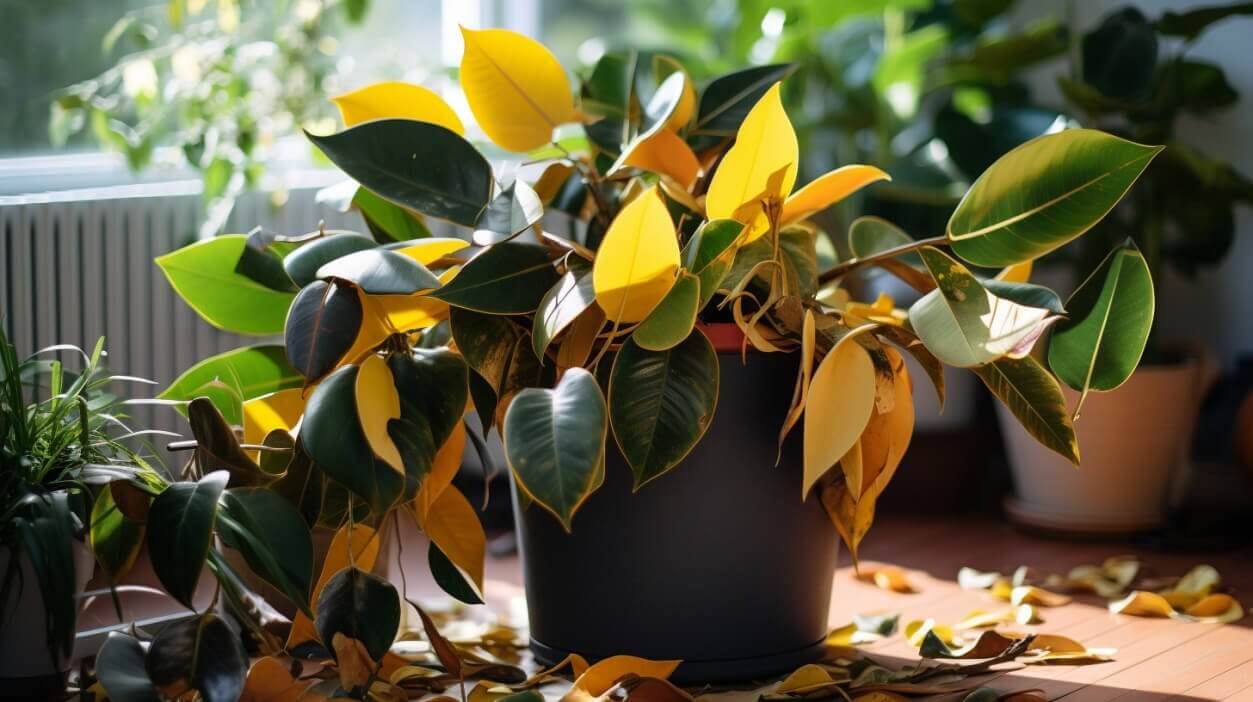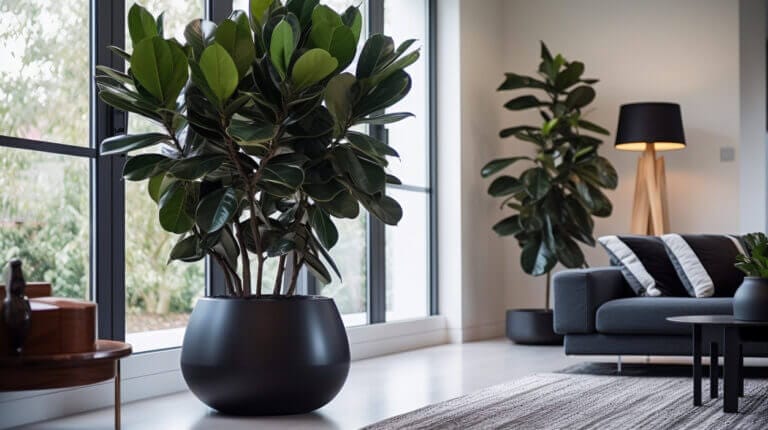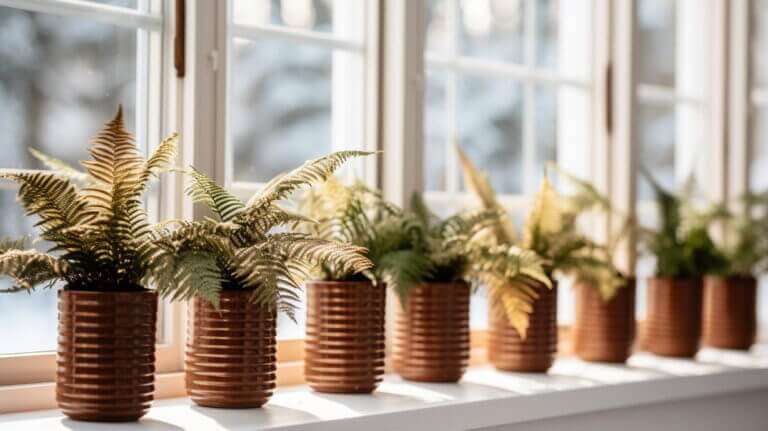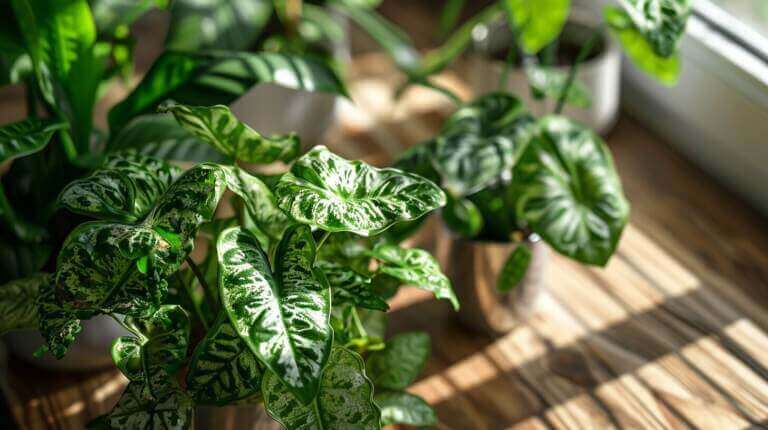Have you recently noticed that your rubber tree plant leaves are drooping? Don’t worry, you’re not alone! Many plant owners experience this issue. The good news is, with a little understanding and care, you can revitalize your rubber plant and bring it back to its full glory.
Understanding Rubber Tree Drooping Leaves: Causes and Solutions
Before diving into the solutions, it’s essential to understand why your rubber plant leaves are drooping in the first place.
- Overwatering: One common cause of drooping yellow leaves is overwatering. Rubber plants like to dry out between waterings, so make sure you’re not giving them too much water.
- Underwatering: On the other hand, underwatering can also lead to drooping leaves in rubber plant. If the soil is bone dry and your plant is parched, it’s time to give it a good drink. Water the plant thoroughly
- Inadequate Drainage: Poor drainage can suffocate the roots and cause water to pool, leading to drooping leaves. Ensure your rubber plant is potted in a container with drainage holes to prevent waterlogged soil.
- Lack of Humidity: Rubber plants thrive in humid environments. Dry air can cause the leaves to droop. Consider using a humidifier or placing a tray of water near the plant to increase humidity.
- Insufficient Light: Rubber plants require bright, indirect light to flourish. If your plant is not getting enough light, the leaves may droop. Consider moving it to a brighter location or investing in artificial grow lights.
- Nutrient Deficiency: A lack of essential nutrients can weaken your plant and cause drooping rubber plant leaves. Use a balanced fertilizer specifically formulated for houseplants to ensure your rubber plant gets the nutrients it needs.
- Pest Infestation: Certain pests like spider mites or mealybugs can damage your rubber plant’s foliage, causing it to droop. Regularly inspect your plant for any signs of pests and take appropriate measures to control the infestation.
Common Causes of Rubber Plant Leaves Drooping
As a plant lover and proud owner of a rubber plant, you may have encountered the frustrating sight of droopy rubber plant’s leaves on your beloved foliage. But fear not! There are several common causes for this issue, and with a little love and care, you can revive your plant and restore its lush beauty.
Drooping Rubber Plant Due To Insufficient Watering and Dehydration
One possible reason for drooping leaves is insufficient watering and dehydration. Rubber plants require a moderate amount of water, and the top inch of soil should be slightly moist. If the soil becomes too dry, the leaves may start to droop. To remedy this, ensure regular watering, taking care not to overwater and cause root rot. A good practice is to check the moisture level of the soil using your finger or a moisture meter before watering.
Droopy Rubber Plant Cause By Overwatering and Root Rot
Overwatering is another common cause of drooping rubber plant leaves. When the roots are constantly saturated, they can become waterlogged and susceptible to rot. This can lead to wilting and drooping leaves. If you suspect overwatering, allow the soil to dry out before watering again. It’s important to ensure proper drainage and avoid leaving stagnant water in the plant’s saucer.
Environmental Stress and Improper Lighting Cause Drooping Rubber Plant
Environmental factors and lighting can also contribute to drooping rubber plant leaves. Rubber plants thrive in bright, indirect light, but direct sunlight can scorch their leaves. If your plant is exposed to direct sunlight, consider moving it to a location with filtered light. Additionally, extreme temperatures, drafts, or sudden changes in temperature can stress the plant and cause leaf drooping. Provide a stable and consistent environment for your rubber plant to thrive.
Remember, reviving a drooping rubber plant may take time. Be patient and implement these fixes while closely monitoring your plant’s progress. With proper care and attention, your rubber plant will regain its vitality and grace your space with its vibrant, upright leaves once again.
Here’s a recap of the common causes and fixes for drooping rubber plant leaves:
| Common Causes | Fixes |
|---|---|
| Insufficient watering and dehydration | – Ensure regular watering, checking soil moisture levels before watering. – Avoid overwatering. |
| Overwatering and root rot | – Allow the soil to dry out before watering again. – Ensure proper drainage.- Avoid waterlogging. |
| Environmental stress and improper lighting | – Place the plant in bright, indirect light.- Avoid direct sunlight and extreme temperature changes.- Provide a stable and consistent environment. |
So go ahead, rescue your droopy rubber plant and bring it back to life with these helpful tips!
Fixing Rubber Plant Leaves Drooping
Hello fellow plant lovers! If you’ve noticed your rubber plant leaves drooping and looking sad, don’t worry, there are some simple fixes to get those leaves standing tall and proud again. As a plant enthusiast myself, I’ve dealt with my fair share of droopy leaves, so I’m here to help you out!
Proper Watering Techniques and Humidity Control
One of the most common reasons for rubber plant leaves drooping is overwatering or underwatering. Finding the perfect balance is key. Make sure to water your plant thoroughly, allowing excess water to drain out of the bottom of the pot. Always check the moisture level of the soil before watering again. Rubber plants prefer slightly moist soil, but not soggy conditions.
Humidity is also crucial for these tropical beauties. Try misting the leaves regularly or placing a humidifier nearby to provide the necessary moisture. You can also create a humidity tray by placing a shallow tray filled with water beneath the plant. As the water evaporates, it increases the humidity around the plant.
Adjusting light levels and providing suitable lighting conditions
Lighting plays a significant role in the health of your rubber plant foliage. Insufficient light can cause drooping leaves, while excessive light can scorch them. Find a bright spot in your home where your rubber plant can receive indirect, filtered light. Avoid placing it in direct sunlight, as it can lead to leaf burn.
If you find your rubber plant leaning towards one side, rotate the pot every few weeks to ensure even growth. Consider using artificial grow lights if your home doesn’t receive adequate natural light.
Checking for pests and diseases
Sometimes, rubber plant drooping can be a sign of pest infestation or disease. Keep an eye out for common pests like mealybugs, spider mites, and scale insects. If you spot any, treat your plant with a mild insecticidal soap or wipe the leaves with a damp cloth.
Inspect the plant for any signs of fungal or bacterial infections such as leaf spots or discoloration. Remove any affected leaves and improve air circulation around the plant by avoiding overcrowding.
With these simple fixes and a little bit of TLC, your rubber plant will soon regain its luscious and upright appearance. Remember, plants are resilient, and with proper care, they can bounce back beautifully! Happy gardening!
Additional Measures to Revive Sagging Foliage
Pruning and Removing Damaged Leaves
One of the first things you can do to revive your rubber plant’s drooping leaves is to prune and remove any damaged or wilting leaves. This will not only improve the plant’s appearance but also allow new healthy growth to occur. Use clean pruning shears to carefully trim off any leaves begin to turn brown, yellow or wilted.
Fertilizing and Providing Necessary Nutrients For Indoor Plant
A lack of nutrients can contribute to drooping foliage in rubber plants. To revive the leaves, consider fertilizing the plant with a balanced liquid fertilizer specifically designed for indoor plants. Follow the instructions on the fertilizer packaging for the correct dosage and frequency. Additionally, ensure that your plant is receiving adequate sunlight, as this is essential for photosynthesis and plant growth.
Repotting and Improving Drainage
If your rubber plant is root-bound or if the soil is retaining too much moisture, it can lead to sagging foliage. In such cases, repotting the plant can help improve the root health and overall drainage. Select a larger pot with drainage holes and use a well-draining soil mixture. Gently remove the plant from its current pot, loosen the root ball, and place it in the new pot. Fill in the remaining space with the indoor plant soil mixture and water thoroughly.
Regularly check the moisture levels of the soil and water your rubber plant accordingly. It’s important to maintain a balance of moisture without overwatering. Avoid allowing the plant to sit in water as this can lead to root rot and further issues with drooping leaves.
By following these additional measures, you can help revive your rubber plant and encourage healthy, vibrant foliage to return. Remember to be patient and consistent with your care, as it may take some time for the plant to recover fully. With a little bit of effort and attention, your rubber plant will soon be back to its flourishing self!
FAQ
Why are my rubber plant leaves drooping?
Drooping leaves in rubber plants can be caused by a variety of factors such as over or under watering, insufficient light, temperature stress, or pest infestation.
How do I know if my rubber plant leaves are drooping?
Drooping rubber plant leaves will appear limp and wilted. They may also start to turn yellow or brown.
What should I do if my rubber plant leaves are drooping?
The first step is to identify the cause of the drooping. Check the soil moisture, lighting conditions, and the overall health of your plant. Once you determine the cause, you can take appropriate action to remedy the situation.
What can cause my rubber plant to droop?
Several factors can cause your rubber plant to droop, including over or under watering, lack of proper lighting, temperature extremes, or nutrient deficiencies.
How can I help my plant if the leaves are drooping?
To help your drooping rubber plant, make sure you are providing adequate water, but not overwatering. Adjust the lighting conditions to ensure your plant is getting enough light, but not direct sunlight. Check the temperature around your plant and make sure it is within the ideal range for rubber plants.
Should I repot my rubber plant if the leaves are drooping?
Repotting your rubber plant may be necessary if the roots are overcrowded or if the current potting mix is not providing adequate drainage. However, repotting should be done with caution and only if necessary.
Q: How can I save my rubber plant from drooping leaves?
To save your rubber plant from drooping leaves, you should first identify the underlying cause and take appropriate action. This may involve adjusting watering, improving lighting conditions, or addressing any pest issues.
How often do rubber plants need to be watered?
Rubber plants should be watered when the top inch of soil feels dry. The frequency of watering will depend on factors such as temperature, humidity, and the size of the plant.
Can moving the plant cause drooping rubber plant leaves?
Yes, sudden changes in the plant’s environment, such as moving it to a different location or exposing it to drafts, can cause the leaves to droop.
Is there a way to fix drooping rubber plant leaves?
Yes, once you identify the cause of the drooping, you can take appropriate steps to fix it. This may involve adjusting watering, improving lighting conditions, or providing a more suitable environment for your rubber plant.







